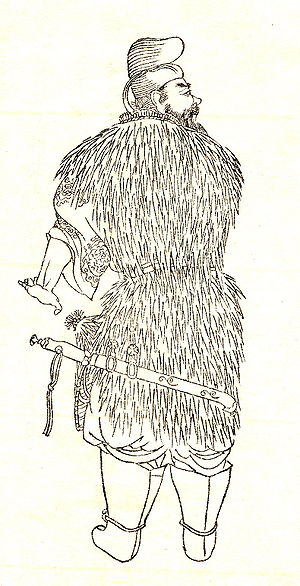
Mononobe no Moriya
Encyclopedia

was an Ō-muraji
Muraji
Muraji . Muraji was an ancient Japanese hereditary title denoting rank and political standing that was reserved for the most powerful among the Tomo no Miyatsuko clans, which were clans associated with particular occupations...
, a high-ranking clan head position of the ancient Japanese Yamato state
Yamato period
The is the period of Japanese history when the Japanese Imperial court ruled from modern-day Nara Prefecture, then known as Yamato Province.While conventionally assigned to the period 250–710 , the actual start of Yamato rule is disputed...
, having inherited the position from his father Mononobe no Okoshi. Like his father, he was a devoted opponent of Buddhism
Buddhism
Buddhism is a religion and philosophy encompassing a variety of traditions, beliefs and practices, largely based on teachings attributed to Siddhartha Gautama, commonly known as the Buddha . The Buddha lived and taught in the northeastern Indian subcontinent some time between the 6th and 4th...
, which had recently been introduced to Japan from the mainland.
Alongside Nakatomi no Katsumi, Moriya worked to counteract the efforts of Soga no Umako
Soga no Umako
was the son of Soga no Iname and a member of the powerful Soga clan of Japan.Umako conducted political reforms with Prince Shōtoku during the rules of Emperor Bidatsu and Empress Suiko and established the Soga clan's stronghold in the government by having his daughter married with members of the...
, another high-ranking noble who supported the adoption of Buddhism. Though Mononobe and Nakatomi saw brief success under the reign of Emperor Bidatsu
Emperor Bidatsu
was the 30th emperor of Japan, according to the traditional order of succession.Bidastsu's reign spanned the years from 572 through 585.-Traditional narrative:Bidatsu was called in the Nihonshoki....
(572-585), his successor, Emperor Yōmei
Emperor Yomei
was the 31st emperor of Japan, according to the traditional order of succession.Yōmei's reign spanned the years from 585 until his death in 587.-Traditional narrative:...
, became Buddhist and so Mononobe's fortunes turned.
Following the death of Emperor Yōmei in 587, Mononobe's party and Soga's each sought to influence the succession. The dispute quickly erupted into outright battle, in which Mononobe no Moriya is credited with setting fire to the first Buddhist temples in Japan, and tossing the first images of the Buddha, imported from Baekje
Baekje
Baekje or Paekche was a kingdom located in southwest Korea. It was one of the Three Kingdoms of Korea, together with Goguryeo and Silla....
, into the canals of the city of Naniwa
Osaka
is a city in the Kansai region of Japan's main island of Honshu, a designated city under the Local Autonomy Law, the capital city of Osaka Prefecture and also the biggest part of Keihanshin area, which is represented by three major cities of Japan, Kyoto, Osaka and Kobe...
(now Osaka). The conflict culminated in the battle of Shigisan
Battle of Shigisan
The Battle of , , , , , or was a battle fought in 587 between Soga no Umako and Mononobe no Moriya at the riverside of the river in Kawachi Province, Japan near Mount Shigi. The battle practically exterminated the Mononobe clan, the most powerful opponent of Buddhism....
. There, the Soga were victorious, and Mononobe no Moriya was killed, along with Nakatomi no Katsumi and the young prince they sought to place on the throne.

